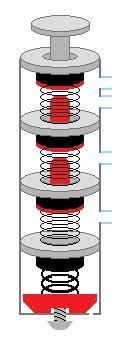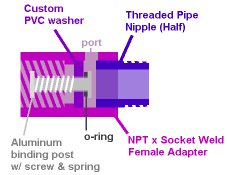
So, air enters the assembly from the top-most tube opening. The air builds up pressure and the spring that holds the seal in place is compressed, allowing the seal to open, and air builds up in the second chamber until the spring in the third chamber compresses, allows the seal to open, and then air builds up pressure in the third chamber.
If you continue to increase pressure (pumping more) then the Over-Pressure-Release-Valve will kick in. The spring that holds the bottom most seal in place is a bit beefier than the others. The screw acts as a sort of regulator on air pressure. The more you tighten it, the more pressure is required to compress the spring enough to open the valve (because the spring is being pressed more firmly against the seal; the screw pushes the red plastic cap which pushes the spring up against the seal).
After the assembly is pressurized, depressing the detonator slightly allows air to flow out the top of the assembly so there is back pressure in the two top-most tube openings, so the blast chambers attached to them will fire. This means that, theoretically, it wouldn't matter which tube opening air came in on; the first and the second would both work. I can't think of any reason why you would need to switch it, but maybe in a tight squeeze it could make a difference.
After air releases from the top chamber, the base of the detonator pushes against the red post of the next seal-post-piece. As you continue to depress the detonator, the base of the detonator presses hard enough against the post beneath it and causes the seal to open in the second chamber, creating back pressure and firing the next barrel. Continuing to depress the detonator will cause the second base piece to push against the bottom post and force open the last seal, allowing air to again rush out, creating back pressure, and firing the last barrel.
This is a simple and effective design that I really think could be easily replicated with the proper tools. My goal, however, is to make a homemade version out of very basic modding tools. The length of the detonator post only needs to be long as the combined distance between each base piece and the tip of the next post. This allows the trigger pull to be very short, especially when compared to the Big Salvo and other blasters that don't utilize this inline system.
I hope this explanation was understandable. If you have any questions, feel free to ask.
edit: I just realized this should probably be in General Nerf or something. I'm just not used to creating topics in those forums.
Edited by imaseoulman, 11 September 2008 - 10:22 PM.


















